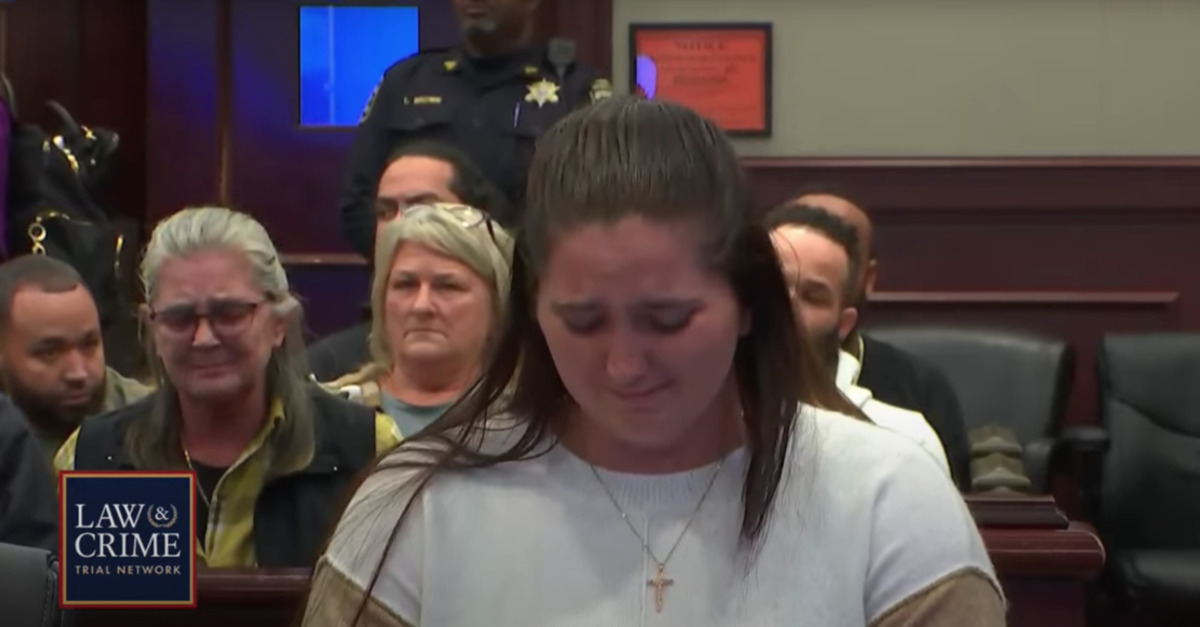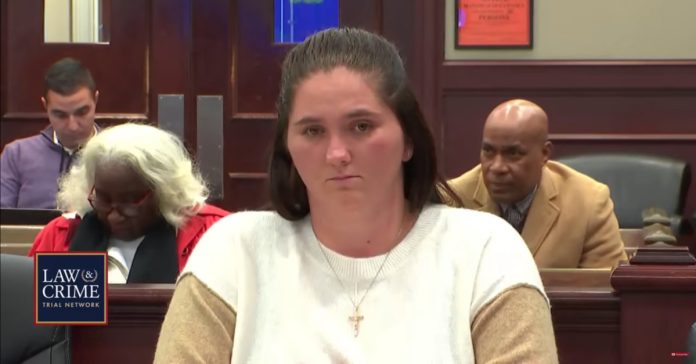A 24-year-old Georgia woman was found responsible for killing a stranger during a citizen’s arrest gone fatally awry several years ago.
Hannah Payne hung her head and cried as the verdict was read aloud in the courtroom in a case overseen by Judge Jewel C. Scott.
After deliberating for roughly 90 minutes, 12 Peach State jurors determined Payne unlawfully attacked and murdered Kenneth Herring, 62, who was shot and killed following a minor traffic accident he is assumed to have caused on May 7, 2019.
Payne faced two counts of felony murder, three counts of possession of a weapon during a crime, and one count each of malice murder, aggravated assault, and false imprisonment. She was found guilty of each and every count. She is set to be sentenced on Friday.
“Kenneth Herring, who was unarmed and minding his own business, was chased down, detained, shot, and murdered,” the lead prosecutor said during the state’s closing arguments on Tuesday afternoon. “You don’t get the death penalty for committing a traffic offense.”

Hannah Payne reacts to her conviction in court on Dec. 12, 2023. (Law&Crime Network)
Taking the stand in a gambled effort to augment her defense, Payne admittedly never drew her often-hip-holstered weapon before the day of the hit-and-run that altered so many lives in Clayton County. But, Payne insisted during her testimony on Dec. 11 that she never meant for her brandished handgun to fire a bullet. Rather, she argued, he shot himself during a struggle for the weapon.
She was partially responsible for the law enforcement response on the day that Herring was killed.
Payne and a semi-truck had a green light when Herring breezed through a red light in his Dodge Dakota pickup truck, causing a minor crash with the semi-truck. Testimony at an earlier hearing suggested that Herring stayed at the scene of the crash for roughly 15 to 20 minutes before ultimately getting back in his truck and driving away.
She was not involved in the initial crash, pulled over and called 911, she testified on Monday.
A witness — a state corrections officer with medic training — also saw the crash and came up to speak to Herring, a detective previously testified. Based on his training, the witness suggested Herring was having a medical emergency — a diabetic shock or something of that nature. For example, Herring was disoriented, displayed red-orange eyes, and had walked around his truck several times.
But Payne thought Herring was drunk.
In her testimony, the defendant said that at various points, she was talking with the truck driver, the truck driver’s employer via his in-truck dispatch radio, and the 911 dispatcher to share information about the crash — principally about the alleged red-light runner being at fault.
“We were kind of just standing there waiting for the police to arrive,” Payne testified.
At one point, the other witness flashed a badge on his breast and identified himself as a “state officer,” the defendant said. Payne did not know the other witness was only a correctional officer “until months later” when informed by her attorney, she testified.
“He’s OK, but he’s definitely inebriated,” the officer allegedly said at one point, Payne testified. This alleged claim prompted her and the semi-truck driver to ask at the same time: “Do you mean he’s drunk?”
After Herring left the initial crash site, however, Payne had settled on the idea that he was drunk. She got back into her Jeep and pursued Herring despite being told at least once by 911 not to do so.
“I saw him stopped in the turning lane, so I turned as well,” Payne testified. “When I stopped, I was under the impression, with having 911 on the phone, that I could be a messenger.”
Payne said she initially only intended to get the driver’s license plate information, which she said the 911 dispatcher had asked of her.
The state argued the audio from the 911 call shows the dispatcher was adamant that Payne not pursue Herring. The audio is also clear the defendant was adamant she was going to go after him.
“He is drunk. I’m not,” Payne told the dispatcher before the fatal confrontation. “I’m sorry, but I’m here to tell you I’m not not going to follow him because he is going to cause an accident.”
The defendant claims she got out of her vehicle at an intersection and walked up to Herring — to get him to return to the crash site. What happened next is murky. But once Payne and Herring were within reaching distance, the calculus shifted, and a life was quickly lost.
After the two shouted at one another for a few moments, Herring reached out of his truck and grabbed her, Payne testified on Monday. She claims he ripped her shirt with the grab and eventually “mashed the gas,” briefly dragging her forward with his car.
Payne said she never stopped trying to pull away from Herring and eventually announced that she had a gun to try and get her alleged assailant to let her go. That’s when Payne admittedly drew the gun.
“I pulled it out and immediately started trying to just continue to push against the door with it — like push it away from him” she testified. Then, she said: “He grabbed my hand with the gun in it.”
All the while, the defendant said, she screamed for Herring to stop.
“As he’s pulling it is when it — the trigger went off,” she testified. “After it went off, my entire body kind of fell backwards.”
The state, on the other hand, proved during trial, relying on witness testimony and recordings, that Payne actually cut Herring off with her car, then jumped out and “very aggressively” ran up to Herring’s car, cursed at him, immediately started punching the confused man through his window, took out her gun, threatened to shoot him twice, and “immediately” shot him.
Payne was initially charged with one count of murder. She made $100,000 bond in late May 2019. By mid-June of that year, she was charged with several additional felony counts, and her bond was revoked.
“She’s using deadly force; she wasn’t faced with deadly force,” District Attorney Tracy Graham Lawson said at the time of her initial murder charge. “You cannot claim self-defense and use deadly force unless you’re not the initial aggressor — she is.”
Have a tip we should know? [email protected]

